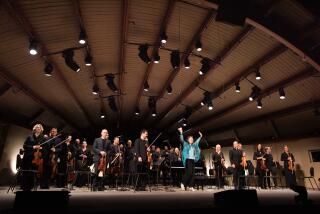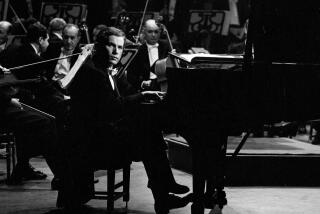A Pianist in Sync With Her Recorder
- Share via
Tuesday night, Gloria Cheng-Cochran, the local pianist with a loyal following and a reputation for hipness, did something not very many performers enjoy doing anymore. She shared the stage with a tape recorder.
For as long as it has been around, electronic music has never had an easy time shaking off its science-fiction connotations, its bleeps and blips symbolizing those nasty little aliens with their wicked machines. Indeed, composers quickly discovered that the liveliest way to present electronic music was as just such drama--the live performer vs. the machine.
Cheng-Cochran wisely avoided such battles in most of the music she chose for the first half of her program, which concluded the innovative Piano Spheres season at the Neighborhood Church of Pasadena.
In Jonathan Harvey’s recent “Tombeau de Messiaen,” for instance, the piano is not in competition with the machine so much as enlarged by it. Here wonderful cascades from the keyboard are underscored by an electronic part that merges with the acoustic sound to create something new and singular--a sort of superpiano full of sparkling resonances that might occur if you could change the tuning of the piano as you played it.
Italian composer Luigi Nono was one of the first composers to experiment with electronics that enhance rather than compete with live acoustic instruments when he composed “ . . . sofferte onde serene . . . “ for Maurizio Pollini in 1976, by pre-recording Pollini and altering the sounds in such a way as to explore the rich resonances of the piano. It is hard to get the balance right, but when it works (intermittently on this occasion) the effect is like sitting under various pianos in a showroom, hearing resonances from skewered angles--a wonderful sound.
Still, however much electronic machines can enhance music, they remain cumbersome. That sense of an awkward bleating instrument was hard to escape in “TimeTexture,” a new piece by Leon Milo commissioned for the program, and one was happiest when it gave up its beeping and simply offered bird song.
And, of course, machines break down. A channel came and went, and it was only after turning speakers, fiddling with wires and a false start that the tape recorder could come through, along with a lot of amplifier noise, on Javier Alvarez’s “Papalotl,” the one composer who had a sense of humor with his use of electronics, turning the computer into an oversized otherworldly Xavier Cugat band.
It was brilliant programming to follow all of this machine music with small elegant purely acoustic pieces, revolving around Messiaen and exploring the almost unfathomable depth of resonance the piano can achieve all by itself.
These pieces reminded us that the sound of the piano has a remarkable kinship with that of bells. Bells call us to weddings and funerals, to pray and to eat, and they ring when love overwhelms us. Messiaen’s sticky, early “Tombeau de Paul Dukas” and Toru Takemitsu’s tiny, telling “Rain Tree Sketch II,” written in memory of Messiaen when he died in 1992, let the piano ululate in its low ranges, comforting in the grounded aspect of the sound.
Boulez’s five-minute “courtes dervies a partir d’Eclat,” a wedding present that appeared on Cheng-Cochran’s fax machine last year, has all the hard-edged clang of his classic score “Eclat.” Meanwhile, Messiaen’s two “Ile de feu” etudes rang in the joyous way Messiaen’s music does when it combines his love of birds, bells, religion and sensuality.
It is often said that the best pianists are the ones who can make their percussive instrument sing. Cheng-Cochran is special in a different way. She can make it ring and ring, with all the colors of the rainbow. She may have gotten some help from the machine, but the human was always boss in this rewarding spiritual journey.
More to Read
The biggest entertainment stories
Get our big stories about Hollywood, film, television, music, arts, culture and more right in your inbox as soon as they publish.
You may occasionally receive promotional content from the Los Angeles Times.











